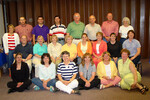Posted date: Apr 11, 2017
by: Jason Padgett
3945 Views
A Fiber Internet infrastructure in St Francis will greatly increase your internet speed. And by 'greatly' I mean 8 to 10 times the bandwidth you are used to, if you are on ATT. The lowest download speed (bandwidth) available in a package is 25 megabytes per second (mb/s). For reference, the highest download speed I ever measured at my store was around 2.5 mb/s. Plus, if you are tired of reaching a data limit and either getting charged extra money, or having your bandwidth limited for the rest of the billing cycle, this simply will not happen with your fiber internet, because there are no data limits. So now you can watch those movies without the buffering breaks, and you can watch all the movies you want without worrying about crossing some data usage threshold.

While going around talking with people around St Francis about this new service, questions have come up and we have been trying to answer as many as possible, but there have been questions we needed to find the answers to ourselves. To help us answer these questions, and also to help us find ways of getting the word out, Elizabeth Jaeger, Director of Marketing, Broadband @ Eagle Communications, came to St Francis on Monday the 10th to talk with our board, and visit the City Counsel to answer any of there questions.
Here are some of the questions we have been asked that we want to cover in this article:
Phone service:
If you are worried about cutting off your phone service through ATT, or you noticed the question about phone service in the sign up form, here is what you should know. There is a residential phone/fiber bundle available. The fiber modem (ONT) that is installed in your house has phone capabilities built in. If you want phone service through the internet connection, it will cost $25. You will be able to transfer your existing number to the new service, or receive a new number if you want. It will have unlimited local and long distance, caller id (both name and number), voicemail, and every other phone feature we could think of.
Why do I need to sign up now:
First of all, get signed up. Even if you are in a contract and don't plan on switching until that contract is up. In the sign up form you are asked if you are in a contract, and when that contract is up. You will not be billed or have service connected until you are ready for the install. But we still want you to let us know through the sign up form because the installer will be able to pre-prepare a connection for your house by creating a splice for your building and leaving enough fiber at the splice to run to the house. Plus, knowing that at some time in the future you are wanting to switch to the Eagle Fiber will give us a better idea of the community's need or desire for this new service.
Pulse:
On the Eagle website, or in the sign up form you will learn of an option called Pulse. This is a managed Wifi service. During the install wifi devices will be placed throughout your house so that there are no dead zones. You will have a strong wireless connection from any room, and during the install, the installer will make sure that all of your devices are connected. If you have any problems in the future with your home networking and wifi, Eagle can remotely access your network and get it fixed.
The install process:
Infrastructure:
We don't yet have a timeline. But roughly, when we reach our goal of 210 sign ups, the phone call is made to order the materials. When the materials arrive the fiber lines start getting run through the town. Behind them, the connections to individual buildings will begin, as the fiber in the alley is available. Eagle hopes to have the first home connection made in June, but the last of the signed up connections may be closer to the end of the year (the biggest reason to sign up early, you want your name at the top of that list, as opposed to the bottom).
My building:
When the installer comes to your house for your install, this is what is happening. From the fiber in the alley, a line is run to your building. This line will be run overhead. The installer will not bury the line. If an existing, underground conduit is available, and that is how you want the line to enter your property, the installer will pull the line through the conduit, but the installer will not have the means to trench, bore, or bury your wire. The fiber line will enter the house and run to a fiber modem (ONT). The installer will then connect one device to verify that the internet service is working. If you ordered the Pulse service, the installer will also install Wifi devices in the house, where needed to ensure full wifi coverage throughout the building. The installer will then connect all of your wifi devices.
Bandwidth:
The bandwidth is the speed that information is allowed to flow to your building (download), and from your devices to the internet (upload). So, using the slowest speed offered through Eagle, 25 million bytes of data is allowed to go to your computer every second (think of a byte as a character, an 'a', or an '&', or a '1'). Households generally use much more download bandwidth than upload, because people are viewing websites, or streaming movies, or accessing some kind of information. Uploads are usually online data back ups, filling in information on a website, or uploading a picture or video on a website. Which is why all of these residential plans have a high download bandwidth and a lower upload bandwidth, this is in line with usage. Commercial entities can use much more upload bandwidth than you would use at home, so the commercial plans have more upload speed available.
Data caps:
A data cap is the amount of information you are allowed to transfer to/from the internet in a given billing cycle. This has nothing to do with speed, it is simply how much data have you used. And when you reach an assigned limit, you are either cut off, slowed down to a crawl, or charged extra money to continue using data.
But forget about data caps, there are no data caps with any of the fiber options.
Why is Fiber to the Premises important:
I doubt anyone will deny that fast internet service is convenient. It is nice to be able to open a page or view a video without delay, but why are we making such a big deal about this? Why is it important?
A fast internet speed and a dependable internet service provide possibilities St Francis has never before realized.
- Businesses which rely heavily on the internet will now be able to function here. Home based internet jobs, or tele-commuting are now possible. Businesses which wanted to locate offices here will no longer move to other towns with faster service.
- In-home medical devices are now a possibility. Heart monitors, sleep monitors, any device which could connect you or a loved one to a doctor or monitoring service. Allowing people to leave the hospital and be in there own homes, because the doctor can have connectivity to the in-home medical equipment.
- Education. The online educational software and information is endless, and now we will not be held back by a buffering symbol.
- This installed fiber infrastructure will ensure our connectivity for years to come. There is no better means of transmitting data, and we will be ahead of most of the world for many years to come.
Whew... that was a long article, and a lot of information. I hope your questions were answered, but if they weren't, here are more resources:
https://www.facebook.com/FibertothePremisesinStFrancis/
http://www.eaglecom.net/stfrancisfiber/
Or please, come talk to one of the St Francis Internet Committee members. We will do our best to answer any question you have. We will even help you get signed up.
Eric Harper
Robert Grace
JR Landenberger
Jason Padgett
Rob Schiltz
Kelly Frewen







